Inca Government › Atahualpa » Ancient origins
Articles and Definitions › Contents
- Inca Government › Ancient History
- Atahualpa › Who Was
Ancient civilizations › Historical and archaeological sites
Inca Government › Ancient History
Definition and Origins
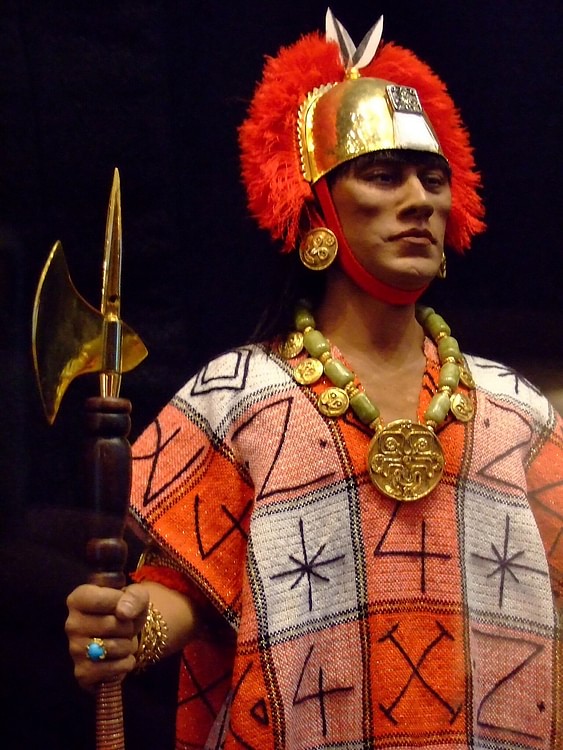
The Inca civilization flourished in ancient Peru between c. 1400 and 1534 CE, and their empire eventually extended across western South America from Quito in the north to Santiago in the south, making it the largest empire ever seen in the Americas. Government and power was held at Cuzco, the Inca capital, which was considered the navel of the world.Eventually 40,000 Incas would govern some 10 million subjects speaking over 30 different languages. Consequently, the centralised Inca government, employing a vast network of administrators, governed over a patchwork empire which, in practice, touched local populations to varying degrees. Inca government, therefore, relied heavily on a combination of personal relations, state largesse, ritual exchange, law enforcement and military might.
HISTORICAL OVERVIEW – THE EMPIRE
Cuzco became a significant centre sometime at the beginning of the Late Intermediate Period (1000-1400 CE). A process of regional unification began from the late 14th century CE, and from the early 15th century CE, with the arrival of the first great Inca leader Pachacuti ('Reverser of the World'), the Incas began to expand in search of plunder and production resources, first to the south and then in all directions, and so they built an empire which stretched across the Andes.
The rise of the Inca Empire was spectacularly quick. First, all speakers of the Inca language Quechua (or Runasimi) were given privileged status, and this noble class then dominated all the important roles within the empire. Eventually a nationwide system of tax and administration was instigated which consolidated the power of Cuzco. The Incas themselves called their empire Tawantinsuyo (or Tahuantinsuyu) meaning 'Land of the Four Quarters'.
THE INCAS IMPOSED THEIR RELIGION, ADMINISTRATION, AND EVEN ART ON CONQUERED PEOPLES.
THE INCA KING
The Incas kept lists of their hereditary kings (Sapa Inca, meaning Unique Inca) so that we know of such names as Pachacuti Inca Yupanqui (reign c. 1438-63 CE), Thupa Inca Yupanqui (reign c. 1471-93 CE), and Wayna Qhapaq (the last pre-Hispanic ruler, reign c. 1493-1525 CE). It is possible that two kings ruled at the same time and that queens may have had some significant powers, but the Spanish records are not clear on both points. The king was expected to marry on his accession, his bride sometimes being his own sister. The queen ( Qoya ) was known as Mamancik or 'Our Mother' and could wield some influence both on her husband and via her kin group, particularly in selecting which son might become the official heir to the throne. The Qoya also had significant wealth of her own which she could dispose of as she wished.
The Sapa Inca was an absolute ruler whose word was law. He controlled politics, society, the empire's food stores, and he was commander-in-chief of the army. Revered as a god he was also known as Intip Churin or 'Son of the Sun'. Given this elevated status he lived a life of great opulence. Drinking from gold and silver cups, wearing silver shoes, and living in a palace furnished with the finest textiles, he was pampered to the extreme. He was even looked after following his death as the Inca mummified their rulers and later 'consulted' them for their opinion on pressing state affairs. Despite his enviable status, though, the king had to negotiate the consent and support of his nobles who could, and did, sometimes depose or even assassinate their ruler. In addition to keeping favour with his nobles the king also had to perform his role as a magnanimous benefactor to his people, hence his other title Huaccha Khoyaq or 'Lover and Benefactor of the Poor'.
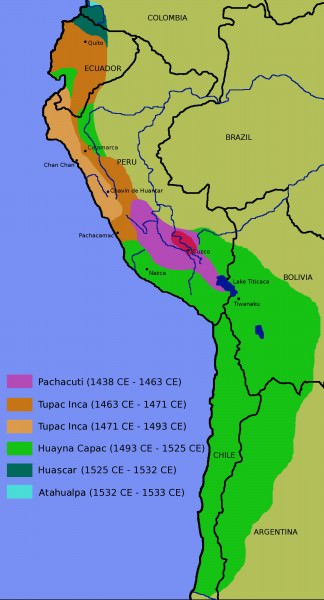
Map of the inca Empire
THE INCA NOBLES
Inca rule was, much like their famous architecture, based on compartmentalised and interlocking units. At the top was the king, his high priest ( Willaq Umu ) – who could also act as a field marshal - and ten royal kindred groups of nobles called panaqa.These nobles could form and instigate policy in councils with the king and, even more importantly, influence the final choice of the king's successor which was rarely simply the eldest son. Indeed, many royal accessions were preceded by intrigue, political maneuvering, coups, and even assassinations to promote a particular kin group's candidate. This may well be why later Inca kings married their own sister so as to avoid widening the elite power base at the very top of the government structure.
Next in line to the panaqa came ten more kindred groups more distantly related to the king and divided into two halves: Upper and Lower Cuzco. Then came a third group of nobles not of Inca blood but made Incas as a privilege. This latter group was drawn from that section of the population which had inhabited the region when the Incas had first arrived. As all of these groups were composed of different family lines, there was a great deal of rivalry between them which sometimes broke out into open warfare.
THE INCA ADMINISTRATORS
At the bottom of the state apparatus were locally recruited administrators who oversaw settlements and the smallest Andean population unit the ayllu, which was a collection of households, typically of related families who worked an area of land, lived together, and provided mutual support in times of need. Each ayllu was governed by a small number of nobles or kurakas, a role which could include women.
Local administrators collaborated with and reported to over 80 regional-level administrators (a tokrikoq ) who were responsible for such matters as justice, censuses, land redistribution, organizing mobile labour forces, and maintaining the vast network of roads and bridges in their jurisdiction. The regional administrators, who were almost always ethnic Incas, reported to a governor responsible for each quarter of the empire. The four governors reported to the supreme Inca ruler in Cuzco. To ensure loyalty, the heirs of local rulers were also kept as well-kept prisoners at the Inca capital. The most important political, religious, and military roles within the empire were, then, kept in the hands of the Inca elite, called by the Spanish the orejonesor 'big ears' because they wore large earspools to indicate their status. To better ensure the control of this elite over their subjects, garrisons dotted the empire and entirely new administrative centres were built, notably at Tambo Colorado, Huanuco Pampa and Hatun Xauxa.
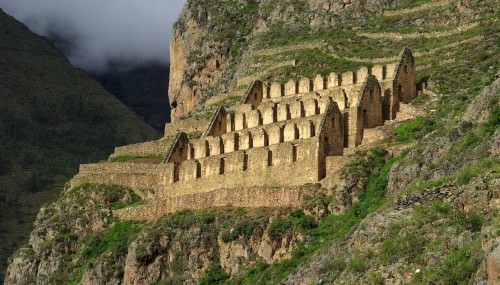
Inca Qollqa
TAXATION & TRIBUTE
For tax purposes annual censuses were regularly taken to keep track of births, deaths, marriages, and a worker's status and abilities. For administrative purposes populations were divided up into groups based on multiples of ten (Inca mathematics was almost identical to the system we use today), even if this method did not always fit the local reality. These censuses and the officials themselves were examined every few years, along with provincial affairs in general, by dedicated and independent inspectors, known as a tokoyrikoq or 'he who sees all'.
As there was no currency in the Inca world taxes were paid in kind - usually foodstuffs (especially maize, potatoes, and dried meat), precious metals, wool, cotton, textiles, exotic feathers, dyes, and spondylus shell - but also in labourers who could be shifted about the empire to be used where they were most needed. This labour service was known as mit'a. Agricultural land and herds were divided into three parts: production for the state religion and the gods, for the Inca ruler, and for the farmers' own use. Local communities were also expected to help build and maintain such imperial projects as the road system which stretched across the empire. To keep track of all these statistics the Inca used the quipu, a sophisticated assembly of knots and strings which was also highly transportable and could record decimals up to 10,000.
Goods were transported across the empire along purpose-built roads using llamas and porters (there were no wheeled vehicles). The Inca road network covered over 40,000 km and as well as allowing for the easy movement of armies, administrators, and trade goods it was also a very powerful visual symbol of Inca authority over their empire.
COLLAPSE
The Inca Empire was founded on, and maintained, by force and so the ruling Incas were very often unpopular with their subjects (especially in the northern territories), a situation that the Spanish conquistadores, led by Francisco Pizarro, would take full advantage of in the middle decades of the 16th century CE. Rebellions were rife, and the Incas were actively engaged in a war in Ecuador, where a second Inca capital had been established at Quito, just at the time when the empire faced its greatest ever threat. Also hit by devastating diseases brought by the Europeans and which had actually spread from Central America faster than their Old World carriers, this combination of factors would bring about the collapse of the mighty Inca civilization before it had even had chance to fully mature.
Atahualpa › Who Was
Definition and Origins
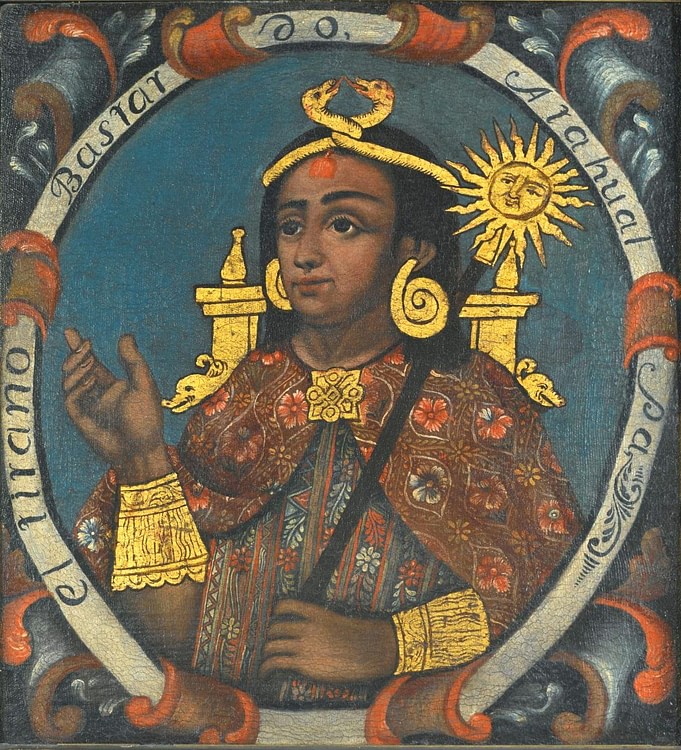
Atahualpa (also Atawallpa) was the last ruler of the Inca empire who reigned from 1532 CE until his capture and execution by the invading Spanish forces led by Pizarro in 1533 CE. The troubled Incas had suffered six years of damaging civil war and Atahualpa was only just enjoying his ascendancy to the throne when the Spanish arrived to turn the Inca world upside down.Further weakened by European-introduced diseases which wiped out millions, the Incas could do nothing against the better-armed invaders who would stop at nothing to gain the fabulous riches of the Americas' largest ever empire.
CIVIL WAR & SUCCESSION
Atahualpa's father Wayna Qhapaq died in 1528 CE of smallpox, the most distinguished victim of the epidemic of European diseases which had spread from central America even faster than the foreign invaders themselves could manage. This epidemic killed a staggering 65-90% of the native population. When Wayna Qhapaq died without choosing a second heir (his first choice Ninan Cuyuchi also died of smallpox) Atahualpa battled for the throne with his half-brother Waskar (or Huascar) in a hugely damaging civil war which the Spanish would be only too glad to take advantage of when they arrived on Inca territory in 1532 CE. Atahualpa was based in the northern capital at Quito while Waskar was at Cuzco. After diplomatic relations soured between the two brothers, open warfare broke out in the north. There followed a series of battles costly to both sides until, after six years of fighting, Atahualpa finally prevailed.
By the time Spanish arrived, Atahualpa had managed to capture Waskar but the factions which had deeply split the empire remained. Waskar was imprisoned and his kin-group was killed, as were those who had supported him. Atahualpa even killed historians and destroyed the Inca quipu records. This was to be a total renewal, what the Incas called a pachakuti or 'turning over of time and space', an epoch-changing event which the Incas believed periodically occurred through the ages. What Atahualpa did not know was that another pachakuti was less than a year away, and this time he would be its victim.
ATAHUALPA'S REIGN MAY HAVE BEEN BRIEF BUT, AS THE SAPA ('UNIQUE') INCA, HE LIVED A LIFE OF EXTREME LUXURY.
Atahualpa's reign may have been brief but, as the Sapa ('Unique') Inca, he lived a life of extreme luxury. Drinking from goldcups, wearing silver -soled sandals and treated as a manifestation of the Sun god Inti on earth, Atahualpa was the head of the largest and richest empire the Americas had ever seen. His taste for opulence was chronicled by the Spanish who said that he once ordered a cloak made only from bat skins. As the Inca king, he had the right to wear even more gold jewellery than the already over-laden nobility. His regalia included a feather headband ( Ilauto ), a golden mace ( champi ), and king-size golden ear-spools. The monarch travelled on a gold and silver litter further embellished with parrot feathers. He was fed food by a servant, and anything the royal person touched was collected and burnt in an annual ceremony to ward off witchcraft. If ever there was a pampered ruler it was the Sapa Inca of ancient Peru.
PIZARRO ARRIVES
On Friday, 15th of November, 1532 CE the 168-man force of Spaniards led by Francisco Pizarro approached the Inca town of Cajamarca in the highlands of Peru. Pizzaro sent word that he wished to meet the Inca king, there enjoying the local springs and basking in his recent victory over Waskar. Atahualpa agreed to finally meet the much-rumoured bearded white men who were known to have been fighting their way from the coast for some time. Confidently surrounded by his 80,000 strong army Atahualpa seems not to have seen any threat from such a small enemy force and he made Pizarro wait until the next day.Then, seated on a low wooden throne and accompanied by all his wives and nobles, the Inca ruler finally came face to face with these curious visitors from another world.
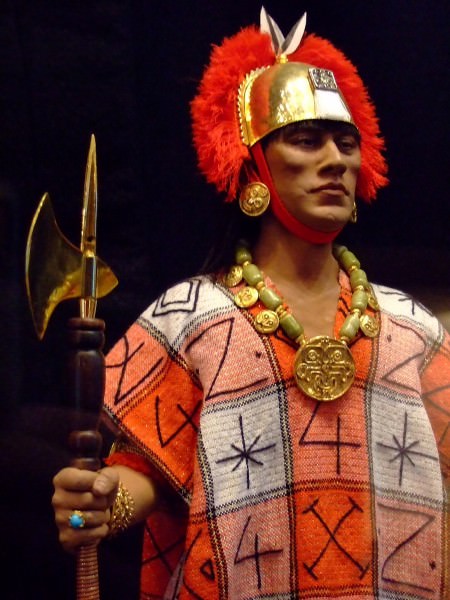
Inca Ruler Atahualpa
ATAHUALPA IS CAPTURED
The first formal meeting between Pizarro and Atahualpa involved a few speeches, a drink together while they watched some Spanish horsemanship and not much else. Both sides went away planning to capture or kill the other party at the first available opportunity. The very next day Pizarro, using the conveniently labyrinth -like architecture of the Inca town to his advantage, set his men in ambush to await Atahualpa's arrival in the main square. When the royal troop arrived Pizarro fired his small canons and then his men, wearing armour, attacked on horseback.
In the ensuing battle, where firearms were mismatched against spears, arrows, slings, and clubs, 7,000 Incas were killed against zero Spanish losses. Atahualpa was hit a blow on the head and captured alive. Either held for ransom by Pizarro or even offering a ransom himself, Atahualpa's safe return to his people would only happen if a room measuring 6.2 x 4.8 metres were filled with all the treasures the Incas could provide up to a height of 2.5 m. This was done and the chamber was piled high with gold objects from jewellery to idols. The room was then filled twice again with silver objects. The whole task took eight months and the value today of the accumulated treasures would have been well over $50 million. Meanwhile, Atahualpa continued to run his empire from captivity and Pizarro sent exploratory expeditions to Cuzco and awaited reinforcements from Panama. Then, having got his ransom, Pizarro summarily tried and executed Atahualpa anyway, on the 26th of July 1533 CE.The Inca king was originally sentenced to death by burning at the stake but, after the monarch agreed to be baptized, this was commuted to death by strangulation.
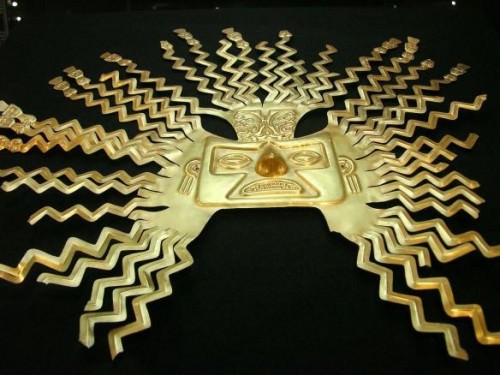
Inca Gold Sun Mask
Some of Pizarro's men thought this was the worst possible response but the wily Spanish leader had seen just how subservient the Incas were to their king, even when he was held captive by the enemy. As one Miguel de Estete described the king receiving visitors during his captivity,
When they arrived before him, they did him great reverence, kissing his feet and hands. He received them without looking at them. It is remarkable to record the dignity of Atahualpa and the great obedience they all accorded him (D'Altroy, 93).
As a living god, Pizarro perhaps knew that only the king's death could bring about the total defeat of the Incas. Indeed, even in death the Inca king exerted an influence over his people for the severed head of Atahualpa gave birth to the enduring Inkarri legend. For the Incas believed that one day the head would grow a new body and their ruler would return, defeat the Spanish, and restore the natural order of things.
THE COLLAPSE OF THE INCA EMPIRE
One of the reasons the Inca empire collapsed so swiftly following Atahualpa's death, perhaps in less than 40 years, was the fact that it was founded on, and maintained by, force, and the ruling Incas (only 40,000) were very often unpopular with their subjects (10,000,000 of them), especially in the northern territories. This was not least because the Incas extracted heavy tribute from conquered peoples – both in kind and labour - and loyal Inca subjects were forced on these communities to better integrate them into the empire. The Inca Empire, in fact, had still not reached a stage of consolidated maturity – it had only just reached its greatest extent a few years before.

Map of the inca Empire
It was a combination of factors then, a veritable perfect storm of rebellion, disease, and invasion, which brought the downfall of Atahualpa and the mighty Inca Empire. In addition, the Inca mode of warfare was highly ritualized where such things as deceit, ambush, and subterfuge were unknown. Inca warriors were highly dependent on their officers, and if these fell in battle, a whole army could quickly collapse in panicked retreat. These factors and the superior weaponry of the Europeans meant the Incas had very little chance of defending a huge empire already difficult to manage.
CONCLUSION
Pizarro received criticism from the Spanish king Carlos I for treating a foreign sovereign so shabbily, and his attempts to install a puppet ruler – Thupa Wallpa, the younger brother of Waskar - failed to restore any sort of political order. The Spanish soon found out that the vast geographical spread of their new empire and its inherent difficulties in communication and control (even if their predecessors had built an excellent road system) meant that they faced the same management problems as the Incas.Added to this was the massive population decline following epidemics and communities still resentful of outside rule. For those local tribes, a change in rulers, unfortunately, brought no respite from a rapacious overlord, once again, eager to steal their wealth and impose on them a foreign religion.
LICENSE:
Article based on information obtained from these sources:with permission from the Website Ancient History Encyclopedia
Content is available under License Creative Commons: Attribution-NonCommercial-ShareAlike 3.0 Unported. CC-BY-NC-SA License